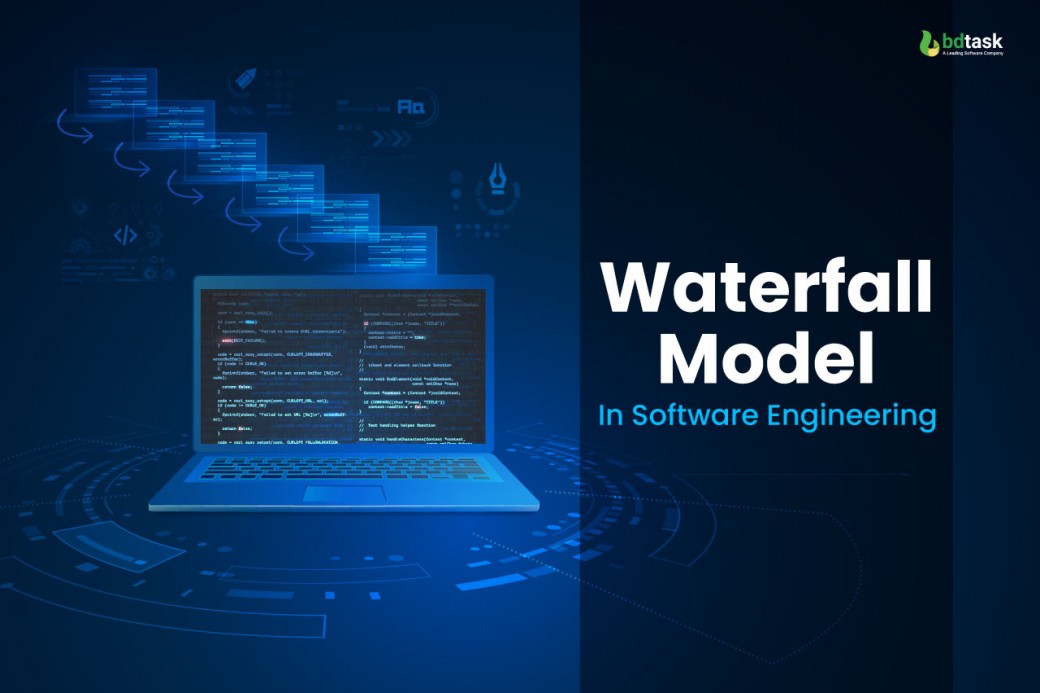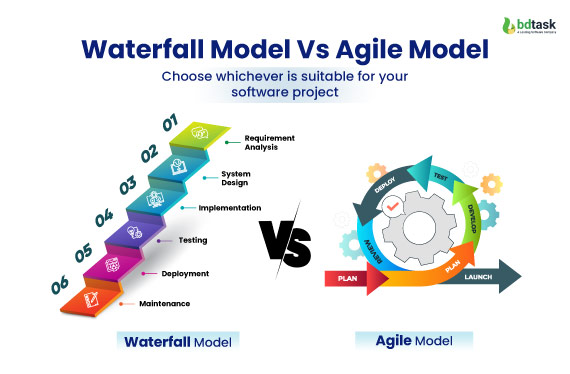Waterfall Model In Software Engineering: First SDLC Models

The initial and mandatory step before starting any software development project is requirement gathering and deciding which software model to follow. It’s better to decide early which SDLC model is most suitable or required by the client for the software project. A developer can divide the task among the team members by determining the SDLC model.
The waterfall model in software engineering is the first software development life cycle model, invented by Herbert D. Benington in 1956. According to Mr. Herbert informally organized the phase of the waterfall model based on the task's priority.
Later, in 1970, Winston W. Royce not only formally sketched a final diagram of the waterfall model of software development life cycle but also set a chronology phase of the waterfall development model.
The waterfall model in software engineering is also called the linear sequential lifecycle model. In this blog, you’ll discover some essential information about the classical waterfall model in software engineering.
- What is the waterfall model in software engineering?
- Waterfall in software engineering diagram
- Phrase of SDLC waterfall model
- Waterfall in software engineering advantages and disadvantages
- Which type of software project is most suitable
What Is Waterfall Model Of Software Development Life Cycle?
The Waterfall Model is traditional and follows a linear sequential approach to construct software development.
Waterfall model is the earliest software development methodology used for software development. Even though there are other software models, the waterfall model is still used in certain situations. However, it has largely been replaced by more flexible and iterative approaches like Agile, V model, spiral, etc.
The biggest drawback of the waterfall model is that you cannot go back to the previous phase to perform any changes or anything else.
Below you’ll see the diagram of waterfall model:
.jpg)
Phase of SDLC Waterfall Model
The Waterfall Model is the oldest and most traditional software development methodology that divides the software development process into distinct sequential ways, and each phase must be completed before moving to the next one. The sequential phases of the Waterfall Model:
1. Requirement Analysis
- Understand and identify the exact requirements your end users are expecting and document them properly
- Note down all the techniques, functions, features, and characteristics of this software
- Brainstorm, study, and analyze the demanded requirements instructed by a client
- Generate a software requirement specification (SRS), a detailed document of the software’s purpose and task.
2. Design
- Transform the collected requirements into a structuralized form, which helps the developer in coding the programming language.
- Give a structured design to the whole software based on the detailed requirements collected in the first phase. Also, specify the software, hardware, architecture, user interface, and system requirements.
3. Implementation
- This phase is also called the coding phase
- Implement coding based on software design specification
- This phase will run unit testing to ensure each component works perfectly.
4. Testing
- All the units will be tested separately and will integrate into one system.
- The developer will run both functional and non-functional testing to ensure whether or not the system meets the requirements.
- Run a comprehensive system testing to determine the quality of the product.
- Use application lifecycle management and traceability matrix to track the testing progress.
5. Deployment
- Deploy the final product in the customer environment
- Do a sanity check of the customer environment to see it’s functioning properly
6. Maintenance
- Main task is to ensure software performance in the customer environment
- Provide maintenance, operational and installation support of the software
- Note and fix issues identify by the customer
- Keep in constant update with latest update
Waterfall Model In Software Engineering Diagram
The waterfall model in software engineering follows a sequential and linear chronology to develop software.
As shown in the waterfall model figure, every phase must be completed before moving to the next one.
And software engineers cannot go back to the previous phase.
For example, a software engineer finishes developing the “implementation phase,” but now developers want to go to the previous phase (system design) for some changes.
In such a case, a developer cannot return to the previous phase. In the waterfall model, once what is done, it’s unchangeable.
Waterfall Model Illustrate Following Phase To Develop A Software:
- Requirement Analysis
- System Design
- Implementation
- Software Testing
- Deployment
- Maintenance
Project Suitable For Waterfall In Software Engineer
Indeed, the waterfall model is the most straightforward, simplest, and independent SDLC model.
The waterfall in software engineering diagram suggests six independent stages. Each phase must be completed before moving to the next one, and cannot return to the previous one.
Not every software project is suitable for the waterfall model. Therefore, before starting a software project, a software developer should analyze whether the project requirement matches with the water lifecycle principles.
- Clear, simple, and well-documented requirement
- Once the software project is underway, there will be no chance for change
- The best model, especially for small software project
- No chance to fulfill the ambiguous requirement
- Will need an ample number of resources and skilled expertise to complete the project
- Will have to follow a strict timeline
- The tools and technology used have to be consistent, and there is no chance for change
Waterfall In Software Engineering Advantages And Disadvantages
Certainly, every SDLC model has some major advantages and disadvantages. And to develop a successful software, you have to watch out for the pros and cons of the selected software development model.
One of the major strengths of the classical waterfall model in software engineering is that every phase is an individual phase and maintains a strong control to ensure every aspect is working properly.
And one of the major weaknesses of the traditional waterfall model is that this model never has the ability to accept any change.
Here Is Some Essential Notable Advantages Of Waterfall Model:
- First mover advantage: simple, easy to understand, and implement
- Require a minimal amount of resources for software development.
- Each phase has its individual testing process to ensure everything works properly before moving to the next phase.
- Best suitable for smaller projects and well-documented for large projects
- Every phase must be completely done before moving to the next phase, so it’s better not to be careless or hurry to complete the project.
- Task assignment is easy since every phase has different functions and responsibilities and performs differently.
- It is easy to forecast the cost and deadline of a software project.
- Unit testing can be run in the middle of the software development process to ensure each phase is working properly.
- An elaborate and well-documented will be created in every phase, making it easy to find and fix various issues.
- The maintenance phase (last phase) has the opportunity to fix the issues/bugs faced by the end-users.
Here Is Some Essential Notable Disadvantages Of Waterfall Model:
- Not recommendable for large or complex projects
- Have to face difficulties in the software development process if the client requirements aren’t clear or variable.
- It is challenging to go back to the previous for any change.
- There is no prototype for demonstration; it might take longer to deliver the final product. Any type of working on software until late during the life cycle
- The whole software project will suffer because of any small change or error in any completed phase.
- Every phase holds multiple documents, and the development process takes time for developers and testers.
- Unit testers perform integration processes at the last phase of SDLC; hence, it becomes difficult to fix or identify issues of the previous phases.
Waterfall Model Vs Agile Model-Choose whichever is suitable for your software project

Waterfall Development Model
- If you want to develop a software project with a waterfall model, all the requirements should be clear and well-documented. Hence, we will have to spend a lot of time planning.
- The success of a software project with a waterfall model depends on implementing the requirements properly.
- When using the waterfall model, a developer will start from the top of the project hierarchy.
- Software project with a waterfall model follows a strict sequence; requirements should be well documented and predictable cost and deadline.
- To develop a software project with a waterfall model, developers must follow several hierarchy levels.
- Huge amounts of time spent communicating with users, especially at the requirement gathering and maintenance sessions. There is no communication in between the project development.
- There is no dependency on the end users during the development or any other phase.
- A clear well document is required at the requirement gathering stage(first phase)
- The work will be divided into different teams, and each development team will be responsible for their given role.
- Software projects with a waterfall model strictly discourage changes in the middle of the development process.
- Testing or quality control activities will only be performed in the last phase.
- The waterfall model is more process-oriented.
- The software project will be delivered at the last stage.
- It is difficult to calculate the progress in the middle of the project.
- Once in a week, a review of the project progress meeting is arranged.
Agile Model In Software Development
- Software project development with the SDLC agile model needs short-term planning since agile is flexible to adapt to any changes at any time.
- The success of software projects with an agile model depends on the level of business value delivered to the clients.
- When using the agile model, the development team keeps self-governing.
- A software project with an agile model creates an iterative every time the project adapts any changes.
- Developers must follow a lesser hierarchy level to develop software projects with an agile model.
- Steady or ongoing communication with users and flexibly adapting the feedback
- Very much dependency on end users, especially for lifetime
- Requirements will continue to be updated occasionally throughout the development process.
- The full development team will take equal responsibility for the software project.
- Software project with the agile model is flexible enough to accept changes at any phase.
- Testing or quality control activities will be performed throughout the project.
- The agile model is more like a people-oriented
- Every new feature will be delivered at the end of each iteration.
- It is easy to calculate the progress of the project at any phase
- Daily, a team standup meeting is arranged to review the project's progress.
3 Major Principle Of Waterfall Development Model
As mentioned above, there are several software engineering models, and each model follows a different principle to develop the software project. Below, I am mentioning three different and major principles of the waterfall model.
- Follows a sequential structure to develop a software project. Developers can’t move to the previous or next phase before completing the present phase. Therefore, there is no chance of accepting any changes or feedback from clients.
- Discourage the client's involvement in the middle of the development process. There is very limited interaction at the requirement gathering phase.
- In-detailed requirement documentation is needed before starting the development process. The documentation will hold the product requirement, development process, and the expected final outcome.
Conclusion
Even though the Waterfall Model in software engineering isn't that preferable in this modern age of software development life cycle.
However, the Waterfall Model can still be suitable for certain projects with stable and well-understood requirements, especially in industries with stringent compliance requirements.










